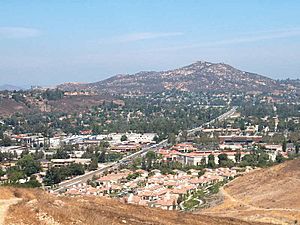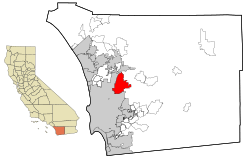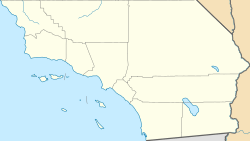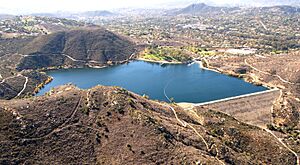Poway, California facts for kids
Quick facts for kids
Poway, California
|
|||
|---|---|---|---|
| City of Poway | |||

The Twin Peaks above Poway in August 2004.
|
|||
|
|||
| Motto(s):
"The City in the Country"
|
|||

Location in San Diego County
|
|||
| Country | |||
| State | |||
| County | |||
| Incorporated | December 1, 1980 | ||
| Government | |||
| • Type | Council-Manager | ||
| Area | |||
| • Total | 39.16 sq mi (101.44 km2) | ||
| • Land | 39.08 sq mi (101.21 km2) | ||
| • Water | 0.09 sq mi (0.22 km2) 0.22% | ||
| Elevation | 515 ft (157 m) | ||
| Population
(2020)
|
|||
| • Total | 48,841 | ||
| • Density | 1,247.22/sq mi (481.477/km2) | ||
| Demonym(s) | Powegian | ||
| Time zone | UTC−08:00 (PST) | ||
| • Summer (DST) | UTC−07:00 (PDT) | ||
| ZIP Codes |
92064, 92074
|
||
| Area code | 858 | ||
| FIPS code | 06-58520 | ||
| GNIS feature IDs | 1661258, 2411480 | ||
Poway (/ˈpaʊ.eɪ/) is a city in San Diego County, California, United States. It's known as "The City in the Country" because of its rural past. In 2020, about 48,841 people lived there. Poway is part of San Diego's North County area.
Contents
Discovering Poway's Past
Early Life in Poway Valley
The Kumeyaay people lived in the Poway area for many centuries. They were here long before Europeans arrived. Tools like arrowheads, spear points, and grinding stones show their presence. You can also find ancient pictographs (rock paintings) on boulders. These paintings are thought to be from the 1500s or even earlier.
How Poway Got Its Name
In the late 1700s, Mission San Diego de Alcalá used the valley for cattle. Records from 1828 call the area "Paguay." The name "Poway" likely comes from a Kumeyaay word. It might mean "arrowhead" (pawii) or "watering hole" (paguay). Some also think it means "the meeting of little valleys." The spelling has changed over time, from Paguai to Poway.
For about 100 years, Poway was mostly used for raising livestock. In 1839, a ranch was granted in the valley, but it wasn't settled.
American Settlers Arrive
American farmers started moving to Poway in the mid-1800s. Not many records from this time exist. The town's history was regularly written down starting in 1894 in the Poway Progress newspaper. By 1887, about 800 people lived and farmed in Poway.
Early farmers had some success growing fruits, grains, and dairy products. However, the town didn't grow much. Poway had fertile soil and a creek, but it lacked easy access to water. This stopped large-scale farming and population growth.
In 1954, the Poway Municipal Water District was created. This allowed the town to use water from the Colorado River Aqueduct. After a sewer system was finished in 1957, new homes were built.
Poway officially became a city on December 1, 1980. It kept its nickname, "the City in the Country." Today, Poway is no longer mainly a farming town. It's now a community where people live and work in the San Diego area. The city has been named a "Tree City" for over ten years.
Poway was affected by major wildfires. Parts of the town were evacuated during the 2003 Cedar Fire and the 2007 Witch Creek Fire.
In 2004, the City of Poway adopted a military group. This was the 1st Light Armored Reconnaissance Battalion from nearby Camp Pendleton. This group has been deployed to Iraq since then.
Some famous pop-punk bands started in Poway, California. These include Blink-182, Unwritten Law, Pivit, and the Frights.
Farming in Poway's Past
The Homestead Act of 1862 encouraged people to move West. Many of Poway's first settlers came to farm. The rich soil was good for many crops. These included peaches, Muscat grapes, apricots, pears, hay, and alfalfa. Some farmers even collected wild bees to make honey. Dairy farming was also profitable.
Most families had a cow for milk and butter. They also kept chickens for eggs and meat. Sometimes, they had a hog for food. Crops sold well in the San Diego area. The Poway Progress newspaper reported on farming between 1894 and 1896:
- Muscat grapes were ripening and sold in San Diego.
- It was a good season for bees and honey.
- Peaches and pears from Poway were excellent.
Farming success depended on winter rainfall. This changed when the Poway Municipal Water District was formed in 1954. With water available, farmers focused on avocados and citrus fruits. New residents moved in, and the farm town became a place with businesses and shopping centers.
Water Supply for Poway
Poway's biggest change happened in the 1950s when water came to the valley. In 1954, citizens voted to create the Poway Municipal Water District. They also voted to connect to the San Diego County Water Authority. A third vote approved borrowing money to build a water system. The first water was delivered in July 1954. In 1972, Poway Dam was built to ensure a steady water supply.
In 1957, the Pomerado County Water District was set up for sewer service. In 1959, the first new homes were built and sold. Poway's population then began to grow. When Poway became a city in 1980, these two water districts became part of the city.
Exploring Poway's Location
Poway is located north of the city of San Diego. It is south of Escondido. Nearby communities include Rancho Bernardo, Sabre Springs, Scripps Ranch, Rancho Peñasquitos, and Ramona to the east.
The city covers about 39.2 square miles (101.4 square kilometers). Most of this area is land, with a small amount of water.
Poway's Weather
Poway has a climate that is a mix of dry and Mediterranean. This means it has hot summers and cool, wet winters.
| Climate data for Poway Valley, CA (extremes from weather.com) | |||||||||||||
|---|---|---|---|---|---|---|---|---|---|---|---|---|---|
| Month | Jan | Feb | Mar | Apr | May | Jun | Jul | Aug | Sep | Oct | Nov | Dec | Year |
| Record high °F (°C) | 95 (35) |
96 (36) |
100 (38) |
103 (39) |
105 (41) |
110 (43) |
114 (46) |
112 (44) |
111 (44) |
105 (41) |
100 (38) |
92 (33) |
114 (46) |
| Mean daily maximum °F (°C) | 67 (19) |
67 (19) |
70 (21) |
72 (22) |
76 (24) |
81 (27) |
82 (28) |
81 (27) |
77 (25) |
72 (22) |
68 (20) |
67 (19) |
73 (23) |
| Mean daily minimum °F (°C) | 44 (7) |
45 (7) |
49 (9) |
53 (12) |
57 (14) |
61 (16) |
62 (17) |
61 (16) |
55 (13) |
48 (9) |
46 (8) |
43 (6) |
52 (11) |
| Record low °F (°C) | 22 (−6) |
25 (−4) |
28 (−2) |
31 (−1) |
39 (4) |
43 (6) |
45 (7) |
46 (8) |
39 (4) |
35 (2) |
26 (−3) |
23 (−5) |
22 (−6) |
| Average precipitation inches (mm) | 2.69 (68) |
3.02 (77) |
2.41 (61) |
0.97 (25) |
0.26 (6.6) |
0.10 (2.5) |
0.03 (0.76) |
0.09 (2.3) |
0.20 (5.1) |
0.57 (14) |
1.28 (33) |
1.93 (49) |
13.55 (344) |
| Source: weather.com(extremes)
NOAA(precipitation) |
|||||||||||||
People and Population
| Historical population | |||
|---|---|---|---|
| Census | Pop. | %± | |
| 1960 | 1,921 | — | |
| 1970 | 9,422 | 390.5% | |
| 1980 | 32,263 | 242.4% | |
| 1990 | 43,516 | 34.9% | |
| 2000 | 48,044 | 10.4% | |
| 2010 | 47,811 | −0.5% | |
| 2020 | 48,841 | 2.2% | |
| U.S. Decennial Census | |||
In 2010, Poway had a population of 47,811 people. Most residents were White (76.9%). About 10.2% were Asian, and 1.6% were African American. People of Hispanic or Latino background made up 15.7% of the population.
The average household in Poway had about 2.93 people. Many households (40.3%) had children under 18 living there. The median age in Poway was 41.3 years old.
In 2000, the median income for a household in Poway was $92,083. For families, it was $103,972. This made Poway one of the more expensive places to live in the U.S.
Poway's Economy
Poway has several large employers. These companies provide many jobs for the community.
Major Employers in Poway
| # | Employer | # of Employees |
|---|---|---|
| 1 | General Atomics Aeronautical Systems | 7,160 |
| 2 | Geico Direct | 1,720 |
| 3 | Poway Unified School District | 1,366 |
| 4 | Delta Design, Inc. | 750 |
| 5 | Pomerado Hospital | 740 |
| 6 | Mitchell Repair Information Company | 400 |
| 7 | Sysco | 385 |
| 8 | Walmart | 370 |
| 9 | Arch Health Partners | 300 |
| 10 | Costco Wholesale | 295 |
Parks and Outdoor Fun
Poway offers many parks and outdoor areas for recreation.
- Aubrey Park
- Blue Sky Ecological Reserve
- Old Poway Park (where you can find the Poway–Midland Railroad and the Poway Historical and Memorial Society)
- Starridge Park
- Poway Community Park
- Lake Poway
Hiking Trails to Explore

- Interpretive Center at Pauwai
- Sycamore Canyon Preserve and Goodan Ranch
- City of Poway Trails
Education in Poway
Poway started its school district in 1871. The first schoolhouse was built in 1885. It was a one-room school for first through eighth graders. Children learned reading, writing, math, and history. Today, the original site is still an elementary school.
The Poway Unified School District (PUSD) has grown a lot. It now has 25 elementary schools, 6 middle schools, and 6 high schools. PUSD is known for its high performance. In 2005, one of its students, Anurag Kashyap, won the National Spelling Bee.
Poway Adult School was started in 1963. It offers classes for adults. These include high school diploma programs, GED preparation, and English as a Second Language (ESL) classes. They also have career training courses and community education classes like yoga and music.
Poway High School
Poway High School is part of the Poway Unified School District. Its sports teams are called the Titans. They compete in many sports, including wrestling, lacrosse, baseball, softball, and football.
Getting Around Poway
Public transportation in Poway is operated by the San Diego Metropolitan Transit System (MTS). MTS bus routes connect Poway to nearby transit centers.
In 1888, the first stagecoach served towns from San Diego to Escondido, including Poway. It stopped at the Poway Post Office and delivered mail. Passengers could ride for a small fee. The stagecoach route could be challenging, with windy mountain trails. The stagecoach line stopped in 1912 when cars became common.
In 1920, Poway set up a County Road Station to maintain roads for cars. By 1961, 80% of Poway's roads were paved. Even today, Poway still has some dirt roads. These roads are used by cars, horses, bikes, and people walking. Parts of Pomerado Road, a main street, were once part of a U.S. highway.
Famous People from Poway
- Brian Awadis, YouTube star known as FaZe Rug
- Bruce Bochy, former Major League Baseball manager
- Fletcher Bowron, former mayor of Los Angeles
- Tom Brunansky, former Major League Baseball outfielder
- Lloyd M. Bucher, U.S. naval officer
- Jeromy Burnitz, former Major League Baseball outfielder
- Brian Patrick Butler, actor and filmmaker
- Brandon Call, actor from Step By Step
- Luis Castillo, former NFL defensive end
- Tom DeLonge, guitarist/singer for Blink-182
- Alex Dickerson, Major League Baseball outfielder
- Lauren Elaine, fashion designer and actress
- Roger Guy English, Guinness World Record holder
- Antonio Gates, former NFL tight end
- David Goeddel, biotechnologist
- Tony Gwynn, Baseball Hall of Famer and former San Diego Padres star
- Christy Hemme, actress, model, and former professional wrestler
- Charley Hoffman, PGA Tour golfer
- Mary Ann Horton, computer expert
- Connor Joe, Major League Baseball outfielder
- David Justice, former Major League Baseball outfielder
- Anurag Kashyap, 2005 National Spelling Bee champion
- Aimee La Joie, actress and TikToker
- Lorenzo Lamas, actor
- Bobby Lee, actor and comedian
- Shawne Merriman, former NFL outside linebacker
- Trevi Moran, singer and YouTube personality
- Phil Nevin, former Major League Baseball player
- Shaun Phillips, former NFL outside linebacker
- Kelsey Plum, WNBA basketball player
- Scott Raynor, original drummer for Blink-182
- Dave Rickards, radio host
- Mark Risley, Emmy-winning director
- Philip Rivers, former NFL quarterback
- Scott Simpson, former PGA golfer
- Jeff Smith, American football player
- Michael Stelzner, founder of Social Media Examiner
- Jesse Taylor, MMA fighter
- Lindsay Taylor, professional basketball player
- LaDainian Tomlinson, former NFL running back
- Unwritten Law, punk rock band
- Steve Vaus, Grammy winner and Mayor of Poway
- Nick Vincent, Major League Baseball pitcher
- Matt Wilhelm, former NFL middle linebacker
See also
 In Spanish: Poway para niños
In Spanish: Poway para niños








